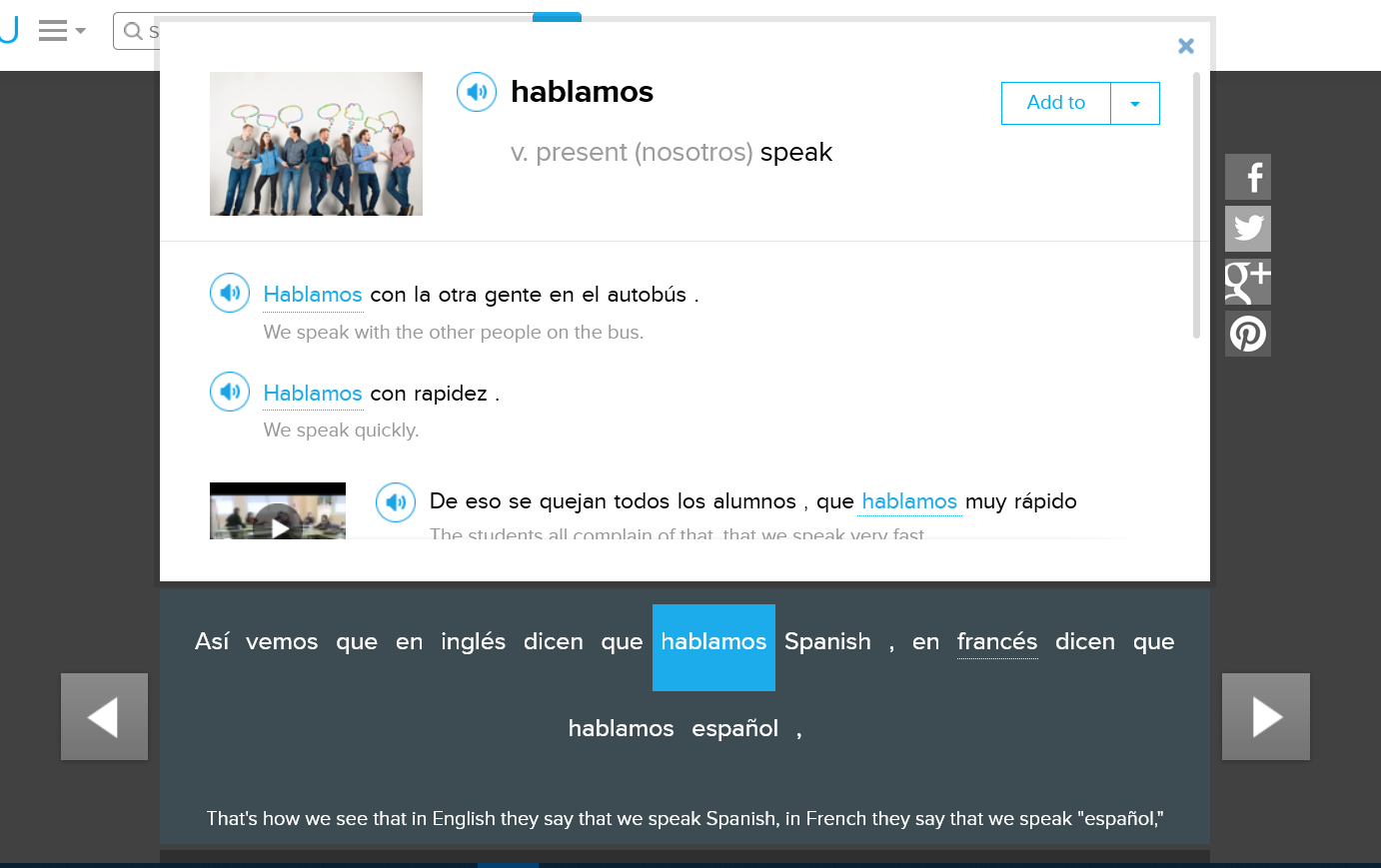
18 Best Programs to Learn Spanish Quickly in 2024
So you’re looking to learn Spanish online? Well, look no further!
We’ve outlined exactly which courses we recommend in 2024 and why.
We’ve been using and building language apps since 2011. Our founder speaks four languages fluently and our team speaks 10+ languages. So we’ve seen and used everything. We’ve seen trends come and go. So here, we’ll separate the substance from the fluff.
Read on to learn the ins and outs of the best programs to learn Spanish that aren’t just engaging—but actually work.
Contents
- 1. Best for Latin American Spanish: Rocket Languages
- 2. Best Authentic Video-Based: FluentU
- 3. Best Tutor Support: BaseLang
- 4. Best Range of Learning Materials: LingQ
- 5. Best for Speaking Practice: Busuu
- 6. Best Course Structure: Babbel
- 7. Best Premium Audio Course: Michel Thomas Method
- 8. Best for Organizations: Transparent Language
- 9. Best for Specialized Spanish: Lengalia
- 10. Best Free College Course: MIT OpenCourseWare
- 11. Best Budget: Open Learn
- 12. Best Free Audio Course: Language Transfer
- 13. Best Vocabulary-Based: Memrise
- 14. Best for Variety of Courses: Coursera
- 15. Best Crash Course: Live Lingua
- 16. Best Podcast-Based: Coffee Break Spanish
- 17. Best for Language Variety: Mango Languages
- 18. Best Spanish Language and Culture Podcast: Notes in Spanish
Download: This blog post is available as a convenient and portable PDF that you can take anywhere. Click here to get a copy. (Download)
1. Best for Latin American Spanish: Rocket Languages
Cost: $99.95 – $259.90
Summary: Rocket Languages is great if you’re not on a budget and are after a comprehensive, classroom-style course covering Latin American culture.
The Rocket Spanish course is full of useful, everyday Spanish and it closely resembles classroom-style teaching.
Classes consist of audio lessons of around half an hour each for a total of over 120 hours of lesson time per level.
Lessons are structured like conversations featuring a learner and a native Spanish speaker. The dialogue is then broken down and the grammar and vocabulary are explained.
The dialogues definitely feel less staged than many other course dialogues. They’re also less formal and more authentic, sounding like a conversation you’d have with a friend.
Rocket Spanish also tracks your progress and allows you to speak and even record your voice in a roleplay-type scenario. After each lesson, you can test yourself on what you learned and rate how easy (or difficult) it was.
You can get started with a free trial, then pay a one-time fee at different tiers. Read our full review here.
| Pros | Cons |
|---|---|
| It teaches you not only about the language but also about the culture surrounding it | It only takes you to upper-intermediate/pre-advanced user of Spanish |
| The material is very comprehensive | It can get repetitive at times |
| The interface is user-friendly and nice to the eyes | It's quite pricey |
2. Best Authentic Video-Based: FluentU
Cost: Free trial, $11.99 – $29.99/month
Summary: FluentU is a great option to learn Spanish through an immersion-based program that adapts to you.
The authentic content exposes you to the language as it’s really spoken, helping you learn more natural speech.
FluentU offers a flexible option to up your Spanish game. You choose what you learn and at what pace.
Through authentic video content, you can improve your Spanish no matter what your current skill level.
You can also click any word in the interactive subtitles to instantly get a definition, associated image and multiple example sentences.

You can even see how words are used in other videos across the site for tons of context.
FluentU also features an adaptive testing system. Quizzes take videos and turn them into Spanish lessons by integrating pictures, video clips and example sentences into exercises and flashcards.
The lessons are fully personalized so that your watch history is considered when presenting questions. FluentU’s algorithm also sets you up for success by teaching based on what you already know.
Start using FluentU on the website or download the app from the iTunes App store or Google Play store. You can start with a free trial, then move to pay a monthly fee or discounted yearly fee.
| Pros | Cons |
|---|---|
| It uses real-world videos, the kind native Spanish speakers would watch | It's not free (although you can get a completely free trial) |
| It's completely personalized. You decide what you want to learn and when | It's completely technology-based, so learners who prefer traditional learning or structured grammar lessons might not enjoy it as much |
| Thanks to the Spaced Repetition System, FluentU will make sure you don't forget what you've learned |
3. Best Tutor Support: BaseLang
Cost: $179/month
Summary: If you’re willing to pay the relatively high fee, you won’t find a better program for native speaker tutoring.
It’s best if you can spare a bit of time to really make the most out of BaseLang.
BaseLang is unique in that it’s based on having unlimited Spanish classes with native teachers, and is very effective at improving your conversational skills!
It offers two programs—Real-World and Grammarless—and provides you with a Spanish curriculum to accompany these courses and the ability to track your progress.
Real-World is the more relaxed option, while Grammarless is an intensive program that claims to get you conversational in just a month.
Access to unlimited tutors is also very flexible—the program allows you to book classes last minute and choose essentially whatever lesson length you want.
Read our full Baselang review here.
| Pros | Cons |
|---|---|
| Highly focused on improving speaking and listening comprehension skills | It's quite expensive if you're on a budget |
| Super flexible scheduling | Limited to Latin American Spanish |
| Unlimited access to hundreds of native teachers | The website can be slow at times |
4. Best Range of Learning Materials: LingQ
Cost: Free plan, $14.99/month
Summary: LingQ shines in its huge variety of audio recordings, videos and podcasts, making it great for those who like learning through different media types. You also get the added support of a forum and language learning community.
If you’re having trouble deciding what type of material you like to learn with, LingQ might be the app for you.
It has a huge library of audio and video materials, plus it lets you import any other Spanish materials you love from around the web.
You’ll have an entire community of language learners to fall back on for support and advice, and you can virtually attend group classes and one-on-one lessons.
Payments are made monthly, with discounts for paying ahead, and you can also test it out with a free trial. Read our full review here.
| Pros | Cons |
|---|---|
| The Spanish audio and video library is really impressive | You need to go Premium if you want to learn fast |
| The LingQ Mini Stories Latino Spanish open course for beginners is a great example of the quality of the program | The content isn't structured to teach you a language from start to finish |
| The forum is very well structured and the community is very helpful | When reading and listening, you need to pause the audio yourself to work with the fragment of text you're reading, or else it'll go on playing and you can easily get lost |
5. Best for Speaking Practice: Busuu
Cost: Free plan; $13.95/month for premium
Summary: Busuu places higher importance on speaking than many other apps, making it a good option for those who wish to improve that skill set. Cultural tips and a community of native speakers also adds to the program’s effectiveness.
Busuu has bite-sized lessons that you can study at your own pace.
It encourages you to develop your speaking skills more than most other apps, with its speech recognition tool and ability to answer prompts through speech.
It’s also strongly focused on listening to dialogues throughout the course or in the community.
Getting social on Busuu is a big plus—you can find people who are native speakers of your target language, exchange messages with them and get feedback on your answers from the wider community.
While there’s a free version, it can be quite limited and only lets you learn one language. So if you’re serious about learning, the paid version is probably the way to go.
You can choose between two premium options and pay for a three-month, twelve-month or twenty-four-month plan.
Read our full review here.
| Pros | Cons |
|---|---|
| Allows you to create a personalized study plan | Only 12 languages available, and only one in the free version |
| Useful cultural tips that help you learn when and how to say something appropriately | Some language courses are lower quality than others |
| Comprehension checks enable you to think critically about what you’re learning | The method and content is lacking slightly in entertainment value |
| Access to a community of native speakers to give feedback | It’s possible to receive incorrect corrections |
6. Best Course Structure: Babbel
Cost: $4.80 – $7.20/month; $190.99 Lifetime plan
Summary: For a practical, well-structured Spanish course, Babbel is worth looking into when you’re first starting. The short, everyday scenarios help you learn the most important parts of the language first.
Babbel focuses on practical language usage, emphasizing instruction in the kind of vocabulary you’d use in real life instead of just teaching random words.
Each lesson is 10-15 minutes, is developed by a team of experienced linguists and focuses on a concept or vocabulary theme. The exercises included help you memorize the content through a combination of text, audio and images.
Lessons range from A1 (beginner) to C1 (proficient) levels, per the Common European Framework of Reference. However, it’s possible to move around the different levels.
And here’s a fun fact: it was the world’s first language learning app!
Registering and taking one lesson is free, but then you’ll need to sign up for a one- to twelve-month plan. Read our full review here.
| Pros | Cons |
|---|---|
| The curriculum has a logical flow of progression | There isn't much offered for advanced learners |
| Teaches applicable, usable language | The exercise format isn't varied much |
| Includes tips that explain concepts related to what you’re learning in a lesson | Limited language choice |
7. Best Premium Audio Course: Michel Thomas Method
Cost: $11.99 – $273 options
Summary: The Michel Thomas Method is best for people who love to learn on the go or enjoy learning through audio. The absence of reading and writing practice may not be for everyone, but it’s effective.
Michel’s no books, no writing, no memorizing method is delivered in a way that makes you feel like you’re in a virtual classroom.
It’s all audio-based, so download it to your smartphone, plug in your headphones and go.
He encourages students not to get stressed with the language and actively promotes not trying to remember what they’re learning. The key is to relax while studying Spanish!
From the very beginning, this course teaches you to speak Spanish by understanding and constructing your own sentences. This gives you the confidence to create proper Spanish sentences in any practical situation.
Being an audio course, it’s great to listen to in the car or on your iPod at the gym—you won’t even feel like you’re studying!
But this course needs to be supplemented with other learning material if you want to move from beginner to intermediate level.
You can get a free sample lesson and booklet before paying a one-time fee if you decide to go ahead with the program.
| Pros | Cons |
|---|---|
| Since it's an audio course, it'll allow you to learn Spanish practically everywhere | It's quite expensive for an audio course |
| It's a nice way for total beginners to get their first contact with the Spanish language | The Spanish you hear comes from teachers or students of Spanish, not native speakers |
| You'll be creating some basic Spanish sentences in a couple of hours | You're not likely to become fluent with this method, and the laid-back method may actually discourage solid learning progress |
8. Best for Organizations: Transparent Language
Cost: $24.95 – $49.95/month; $149.95 – $249.95/year
Summary: Transparent Language is a flexible but well-structured program that lets you practice all language skills with their exercises and methods. You can choose to learn Castilian or Latin American Spanish.
Transparent Language offers online Spanish programs for beginner through advanced students. These flexible programs allow you to choose your own learning path—the lessons give you a starting point.
With activities to practice typing, speaking, writing and reading, you’ll learn the skills you need to understand and communicate in Spanish well.
The program also uses game-like learning methods, and the app is touchscreen compatible, so it’s an engaging option for any Spanish learner.
Read our full Transparent Languages review here.
| Pros | Cons |
|---|---|
| It's very well structured in terms of content | The quality/price ratio isn't the best |
| The lessons are challenging and force you to be focused | There's very little emphasis on grammar |
| The exercises allow you to practice all the major language learning skills | It can get a bit repetitive after a few lessons |
9. Best for Specialized Spanish: Lengalia
Cost: $4.16 – $33.99/month
Summary: If you’re looking to learn Castilian Spanish with a focus on grammar and other specialized topics, Lengalia is worth checking out. It also features handy free tools and courses specifically for travel.
Lengalia offers general grammar courses that range from beginner to advanced.
But this program is unique because it also offers professional courses on specialized Spanish topics including business Spanish, medical Spanish, negotiating and more!
And if you’re considering vacationing in a Spanish-speaking country, you’ll benefit from their “holiday” courses designed for tourists.
The listening, reading, speaking and writing practice will help prepare you for any situation you might encounter. Start with a free trial then move to paying monthly, with discounts for paying ahead of time.
| Pros | Cons |
|---|---|
| Lessons allow you to really practice all four language learning skills | Its user community is rather small and not very engaged |
| The free tools, especially the vocabulary trainer and the verb conjugator, are excellent | Exercises can get very repetitive |
| The courses are very well structured and appropriate for each level | It only includes Castilian Spanish |
10. Best Free College Course: MIT OpenCourseWare
Cost: Free
Summary: MIT OpenCourseWare is perfect if you’ve always wanted to study at a world-renowned university without the price tag.
If you’re organized, you can learn the language and other related topics—like oral communication and Hispanic literature—from those universities.
MIT OpenCourseWare offers more than a dozen free Spanish online courses related to language and culture.
Best of all, these are real MIT courses.
You can download course materials, do assignments and learn just like the students who took this course for credit.
But you’re doing it for free at your own pace. Just search “Spanish” in the search bar, and you’re good to go.
| Pros | Cons |
|---|---|
| It's absolutely free | It could be easy to get lost among so many readings, assignments and resources |
| These are real high-quality MIT courses | The required course books and reading materials need to be bought separately |
| You can download the whole content of the courses and work on them offline | You need to be pretty self-motivated |
11. Best Budget: Open Learn
Cost: Free
Summary: For people on a budget who want to supplement their learning with university-level Spanish courses, Open Learn is an excellent option. The free courses cover all levels and many different topics.
The Open Learn University is a British online charity that provides access to several educational subjects, including an extensive Spanish “syllabus.”
These university-level courses are flexible, groundbreaking and—most importantly—free. Each level is prefaced with a recommendation of previous experience to ensure that you choose the optimal course for your learning needs.
With most courses focused on the beginner to intermediate level, it’s a great way to squeeze in some useful and practical study—like this course on essential beginner’s Spanish for getting around.
You can find tons of them with a quick search. Some courses even come with free letters of participation and badges of completion if you want something to document your learning.
| Pros | Cons |
|---|---|
| The courses are free and very well structured | The courses are short alone |
| They include audio and transcripts, as well as exercises and their answers | Although Open Learn is an excellent platform, it's been created to tease you into becoming an Open University student |
| You can choose from different levels, from complete beginner to advanced | It's not really possible to learn fluent Spanish from the courses alone |
12. Best Free Audio Course: Language Transfer
Cost: Free
Summary: Language Transfer is an excellent course for beginners looking to learn through an unconventional method. It’s audio based, making it good for hands-free learning, and you only pay if you want to!
Known as “the thinking method,” Language Transfer is the brainchild of linguist Mihalis Eleftheriou, who once described his job as “pummeling my brain with languages.”
The course is wholly listening-based and involves transferring your English capabilities to Spanish. Because of this, it’s most suitable for learners who are fluent in English.
The concept is rather novel, natural and highly effective: You take Spanish cognates and verbs and transfer them from English to Spanish.
It encourages your brain to make connections rather than attempting to download a completely new language from scratch.
The course is entirely free, but you might consider making a small donation, as it’s the product of many years of one man’s work and a handful of volunteers.
Read our full Language Transfer review here.
| Pros | Cons |
|---|---|
| The Spanish audio course includes 90 tracks | The course will only teach you some basic Spanish |
| It's perfect for beginners with no prior knowledge of Spanish | There are no transcripts of the audio available |
| The method used is very similar to the Michel Thomas one, but Mihalis makes his course much more enjoyable (and it's completely free!) | You won't hear any native Spanish throughout the course |
13. Best Vocabulary-Based: Memrise
Cost: Free plan, $22.99/month; $130.99/year; $124.99 lifetime
Summary: For the vocabulary-focused visual learners among us, Memrise is an effective program.
However, it’s somewhat limited in the language skills you can practice, so probably not ideal for advanced learners.
Memrise uses flashcards, quizzes, questions and useful interactive resources such as natural speaking clips.
With this combination of methods, you can achieve that native tone, boost your memory and sharpen your listening skills all in one place.
Founded by a memory expert and a neuroscientist, the content is memory-focused, and you can access ample content with a free account.
Memrise serves as a great supplementary resource to your Spanish learning and is a popular choice for many beginner to intermediate learners who are seeking to establish a solid basis in Spanish vocabulary.
The program is free, with the option to upgrade to a subscription for more features. Read our full review here.
| Pros | Cons |
|---|---|
| It uses the Spaced Repetition System | The exercises get quite repetitive after a few sessions |
| It's perfect for beginners and intermediate learners of Spanish | It focuses on vocabulary almost exclusively |
| Users can create their own courses, so there's plenty to choose from | The courses created by the users often contain mistakes |
| The content created by Memrise is of high quality | There's nothing really interesting or challenging for advanced students |
14. Best for Variety of Courses: Coursera
Cost: Free, with some pricing options
Summary: If you don’t mind sifting through the Coursera database, you can find some really effective Spanish courses here—and pretty much for free.
Coursera offers several Spanish online courses for learners.
Although there isn’t as much variety for complete beginners, you can access some excellent courses from reputable institutions on this platform if you’re an intermediate or advanced learner.
One of the best ones is the University of California’s basic course for beginners, which is broken up into five stages.
Despite offering courses from top universities, Coursera gives you more flexibility than an actual college course, as you can move through the materials at your own pace.
It’s also mainly free, which is always a plus for a college course.
| Pros | Cons |
|---|---|
| You can study at your own pace | The number of options is so huge that it can be a bit overwhelming if you don't know where and how to start learning Spanish |
| Courses are free, well-structured and easy to follow | Some of the courses can be (very) outdated |
| All courses include subtitles in several languages | There's not a lot to choose from for complete beginners |
15. Best Crash Course: Live Lingua
Cost: $24/hr for private tutoring; $77/month for group classes
Summary: If you want to learn quickly, for free, and you don’t mind old-fashioned and bad-quality audio, then the FSI courses on Live Lingua are for you.
They’re particularly useful if you want South American Spanish and if you already have a good base to start with.
Live Lingua has taken the FSI (Foreign Service Institute) language courses and enhanced them for learners.
These now free courses were once used by the United States government to prepare diplomats and foreign service workers for their roles abroad. The recordings aim to provide usable, digestible, ready-to-go phrases applicable in the real world.
With over 50 hours of free online Spanish content and a six-month recommended course time, this resource is great for a crash course in Spanish, especially if you’re planning to visit or move to South America.
It can be a little boring and old-fashioned, but the resource is great to use if you want to learn quickly and for free. I’d advise getting a speaking partner on Tandem or a similar app. And don’t forget to supplement your studies with a little grammar practice for a more holistic approach to the language.
Read our full Live Lingua review here.
| Pros | Cons |
|---|---|
| The courses are free and include tons of material, including audio and e-books | The quality of the audio is bad (it was recorded over 50 years ago) |
| The Foreign Service Institute has been high-quality for decades | If drills aren't your thing, you're going to get really bored pretty soon |
| Drills and spaced repetition will allow you to learn faster and better | Some courses can be challenging for complete beginners |
| The content of the dialogues and the sample sentences are easily (re)usable in real-life conversations | If you're bothered by sexist, chauvinistic language, look somewhere else. The courses faithfully represent the time when they were created |
16. Best Podcast-Based: Coffee Break Spanish
Cost: Free plan, courses available for $145/season of 40 lessons
Summary: Coffee Break Spanish is one of the more relaxed, entertaining options for Spanish courses. It covers a vast range of topics over four difficulty levels for free, with the option to upgrade to premium for transcripts and lesson notes.
A personal favorite, the Coffee Break Spanish podcast offers audio material for beginner to intermediate learners in easily consumable doses of 15-20 minutes (more or less) per episode.
The award-winning resource is incredibly well-known in the Spanish learning world and has already been extensively covered online. So if you haven’t done so yet, it’s time you stuck those earphones in, went for a walk and let the hosts guide you from simple vocabulary to complex sentence structures, step by step.
Mark and Cara are engaging, humorous and best of all, entertaining. This makes for an enjoyable listening experience episode after episode.
And it’s free, with the option to upgrade to a subscription for more features. Read our full review here.
| Pros | Cons |
|---|---|
| It's one of the best, most comprehensive Spanish podcasts out there | It's mainly focused on listening and speaking |
| All the episodes can be listened to for free on Spotify | If you want to have scripts and lesson notes from the podcast episodes or the exercises from the Reading Club, you have to go premium |
| There are series of episodes focused on grammar and Spanish culture |
17. Best for Language Variety: Mango Languages
Cost: $7.99 – $17.99/month; $79.99/year
Summary: Mango Languages teaches vocabulary starting from square one using repetition.
A native speaker will teach words and phrases, frequently asking the learner to recall the words and practice pronouncing them. The program uses a lot of repetition—think flashcards, but with audio.
You can choose whether to learn Castilian or Latin American Spanish (or any other of the 70 languages on offer), and the lessons go fairly quickly—they can be done whenever you have a few minutes to spare.
This program is available online or as an app. You can even check with your local library to see if it’s available to you for free.
Here’s our full review of Mango Languages.
| Pros | Cons |
|---|---|
| Words are taught and spoken by native speakers | Foreign scripts and alphabets aren't taught |
| Lots of repetition and frequent pronunciation practice accelerate progress | Not all language courses are as in-depth as others |
| Placement tests and level assessments are included | The content doesn't go as in-depth as some users would like |
18. Best Spanish Language and Culture Podcast: Notes in Spanish
Cost: Free; course packs available for $97-$247
Summary: A great option for auditory learners who are also interested in learning about Spanish culture.
Notes in Spanish began as a podcast that talks about Spanish culture, food and many other topics (in Spanish) from beginner to advanced levels.
These can enrich your knowledge of the world and of the Spanish language at the same time.
The audio episodes are free, and accompanying worksheets and other materials are available for purchase.
If you learn best by listening, this could be a great option.
| Pros | Cons |
|---|---|
| The free plan includes all audio episodes, with the option to pay for downloadable materials | The courses are a bit pricey, although varied |
| There are tons of podcasts available | It can be difficult to get everything you need out of the podcasts without paying for the downloadable study materials |
| Content is suitable for all levels, from beginner to advanced |
There you go! That’s our favorite 18 amazing online courses to learn Spanish in 2024. We hope you’ll find a program that suits your learning preferences.
Give any of these a try and watch your Spanish skills skyrocket in no time.
Stay curious, my friends, and as always, happy Spanish learning!



